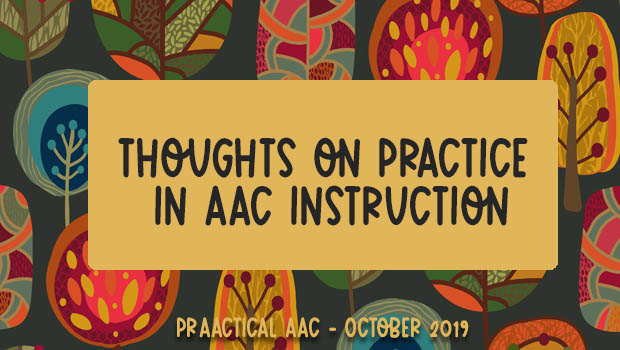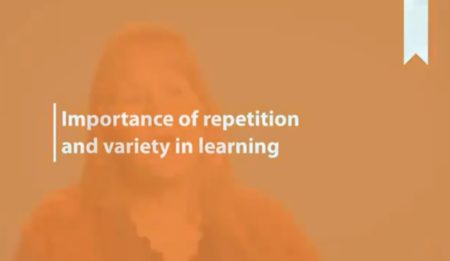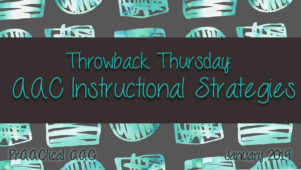Thoughts on Practice in AAC Instruction

- In therapy, Matthew made sentences with many of the vocabulary words he learned 4 months ago. He hasn’t generalized that skill to the classroom yet, largely because it is still quite effortful for him to find the new words and use them to build sentences. With more experience and a lot of practice, this is sure to improve.
- Teesha is learning how to use 2-switch step scanning with her speech-generating device to share her thoughts and make requests. Because she’s relatively new at this, it takes a lot of effort to express herself with the AAC system. Her team is confident that this will eventually become easier and faster for Teesha, but that will only come with a lot of practice.
- Mallory has a lot to say, and, at times, she can hardly contain her enthusiasm for sharing her thoughts and ideas. Often, though, she spends a minute or more looking for the word that she wants, which is frustrating to her and puts a damper on what could have been a wonderful moment of connection.
Here’s a conundrum faced by many service providers: Our AAC learners need a great deal of practice but repetition of the target skill can become boring and tedious. Like the rest of us, there’s a big difference in knowing that practicing a skill is a good idea and actually doing it.
“Practice makes perfect,” my grandmother used to say whether glancing at my misshapen pie crust or uneven stitches, or listening to my piano scales. I knew she was right, but I still cut my piano practice short most of the time and put down the sewing to go outside at every opportunity. Why? Well, for starters, practice was boring. Boring, boring, boring. And to make matters worse, I didn’t much care about being a good seamstress like her or playing beautiful melodies like my cousin. I never got good at either of them, and I was fine with that.
Many people with AAC needs face a similar situation. Communicating with an AAC device won’t become less effortful with Teesha unless she gains a lot of experience in using it. Matthew isn’t likely to start including his new vocabulary words when he communicates while it still takes thought and effort to find those words in her AAC devices. They need a lot of practice. But how can we provide sufficient opportunities for the kind of practice they will engage with?
For the most part, we’ll need to steer clear from the repetitive drills that are so effective in things like articulation therapy or handwriting practice. Occasionally, you may work with a learner who doesn’t mind flashcards or repeating the same skill over and over in a decontextualized task. Those folks are few and far between, though. Most of us don’t thrive under those conditions.
Repetition with variety, a term I first heard from Dr. Karen Erickson, is one key to more positive outcomes. The idea here is that we create practice opportunities that are not boring or tedious by holding the skill constant, but varying other aspects of the instructional experience. It’s incredibly useful in AAC learning, and, as Dr. Caroline Musselwhite reminds us, this concept applies to literacy learning, too.
Here are some ideas that may help you put this concept into AACtion.
- Pick the Right Time for Repetition: When used thoughtfully, repetition can be a valuable part of the learning process. Repetition for the sake of practice (as opposed to repairing a communication breakdown) is something we avoid in conversational interactions and other exchanges where shared meaning and connection is the priority. A better option is to create activities specifically to give multiple practice opportunities with the same skill.
- Get Playful: One way to build in repetition is create a game to do this, or re-purpose an existing game with new rules and materials. Mallory’s clinician began keeping a log of some of the words that her client had a difficult time finding in her SGD. She created word/symbol cards for those, and revised a game so that the players would draw and word/symbol card when it was their turn and say that word prior to advancing their game piece. After a few times, the added practice on those words helped Mallory retrieve them more quickly and with less effort.
- Explain the Rationale: For some learners, a clear explanation of why you’re asking them to say something multiple times can go a long way. Once they understand the purpose of repetition, resistance may fade.
- Show It Off: In some situations, we may want the learner to do the exact same thing a few times in a row with little pause time in between. For students who enjoy the attention of others, we can make this less tedious by having the student ‘show off.’ Teesha can do it once with the SLP who is pushing into the classroom, and then they head on a little victory lap around the room ‘showing off’ the target skill. First stop, her teacher (who gets mega-excited to see what Teesha is showing her), and then onto some friends, and finally the classroom aides. By the end of the victory lap, Teesha got a few more practice opportunities.
- Look for Opportunities Outside of the Therapy/Instructional Session: Teesha had a lot of downtime in her classroom, and some of that overlapped with times when a peer buddy was available. Her teacher set up a few games and activities that would give Teesha practice with her switch scanning skills that she could do with a peer buddy. Some initial coaching was needed, but eventually, the two students could play these games on their own. While Teesha didn’t always choose to play one of these games during her peer buddy free time, it became something they both really enjoyed.
There is no way around it: Most AAC learners need a lot of repetition and practice to advance their skills and become effective communicators. Do you have tried-and-true strategies to build in repetition with variety? We’d love to hear them.
Filed under: Featured Posts, PrAACtical Thinking
Tagged With: intervention strategies, repetition with variety
This post was written by Carole Zangari





1 Comment
Love these ideas for playing games with AAC. For some of my users who are putting words and phrases together and are literate, I use a word search generator to create a search for 2 word phrases (can also be done for single words). Things like “need more, love mom, want milk,” etc. I make the word search so that the words only go from left to right (as in reading) with no up/down, diagonal or backwards words. The child finds the phrases (also printed on the paper) with a highlighter which is easier for most than circling the words, then finds on his AAC. I have several kiddos who LOVE word search and find it very reinforcing while learning AAC vocabulary and use.